2011 FORD SUPER DUTY seat adjustment
[x] Cancel search: seat adjustmentPage 5 of 441
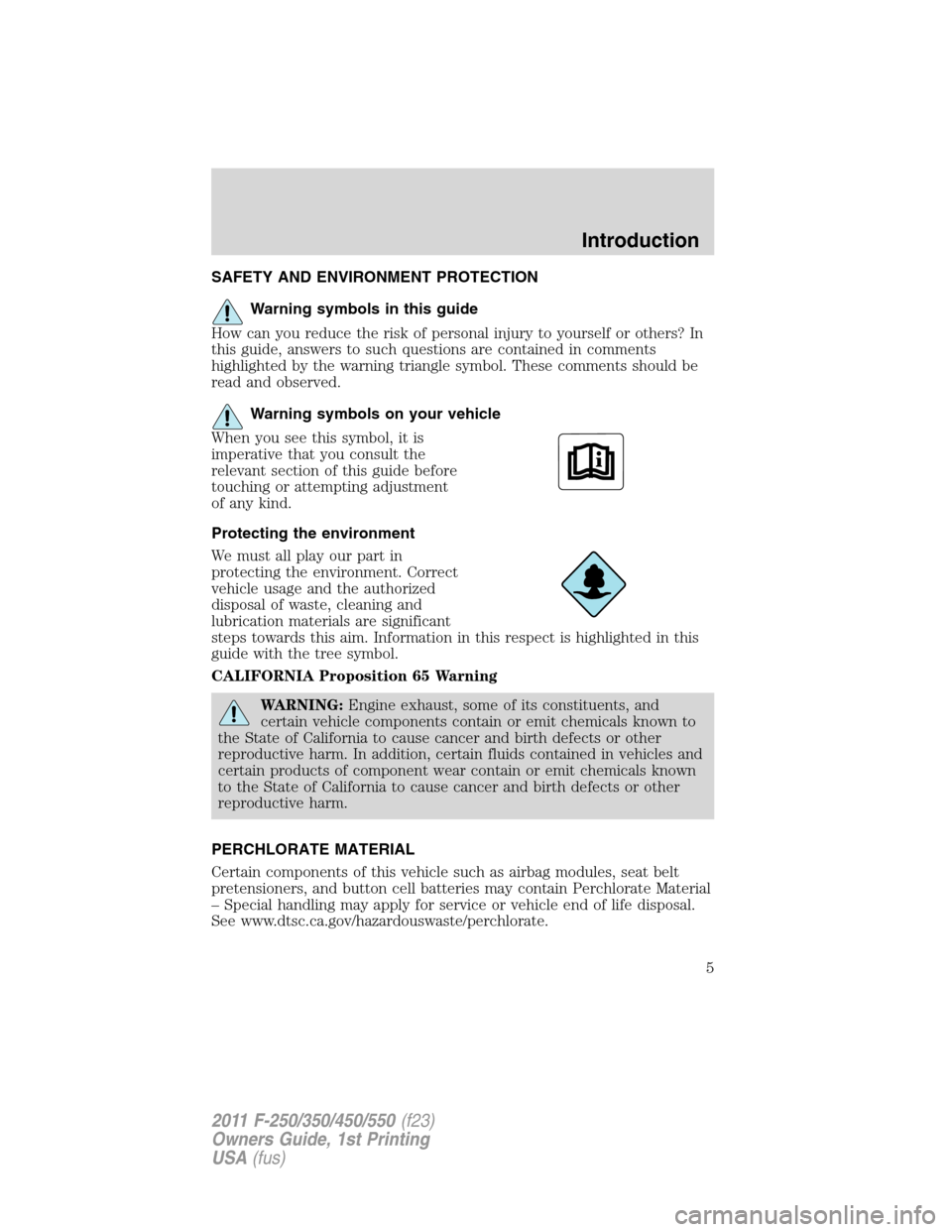
SAFETY AND ENVIRONMENT PROTECTION
Warning symbols in this guide
How can you reduce the risk of personal injury to yourself or others? In
this guide, answers to such questions are contained in comments
highlighted by the warning triangle symbol. These comments should be
read and observed.
Warning symbols on your vehicle
When you see this symbol, it is
imperative that you consult the
relevant section of this guide before
touching or attempting adjustment
of any kind.
Protecting the environment
We must all play our part in
protecting the environment. Correct
vehicle usage and the authorized
disposal of waste, cleaning and
lubrication materials are significant
steps towards this aim. Information in this respect is highlighted in this
guide with the tree symbol.
CALIFORNIA Proposition 65 Warning
WARNING:Engine exhaust, some of its constituents, and
certain vehicle components contain or emit chemicals known to
the State of California to cause cancer and birth defects or other
reproductive harm. In addition, certain fluids contained in vehicles and
certain products of component wear contain or emit chemicals known
to the State of California to cause cancer and birth defects or other
reproductive harm.
PERCHLORATE MATERIAL
Certain components of this vehicle such as airbag modules, seat belt
pretensioners, and button cell batteries may contain Perchlorate Material
– Special handling may apply for service or vehicle end of life disposal.
See www.dtsc.ca.gov/hazardouswaste/perchlorate.
Introduction
5
2011 F-250/350/450/550(f23)
Owners Guide, 1st Printing
USA(fus)
Page 79 of 441
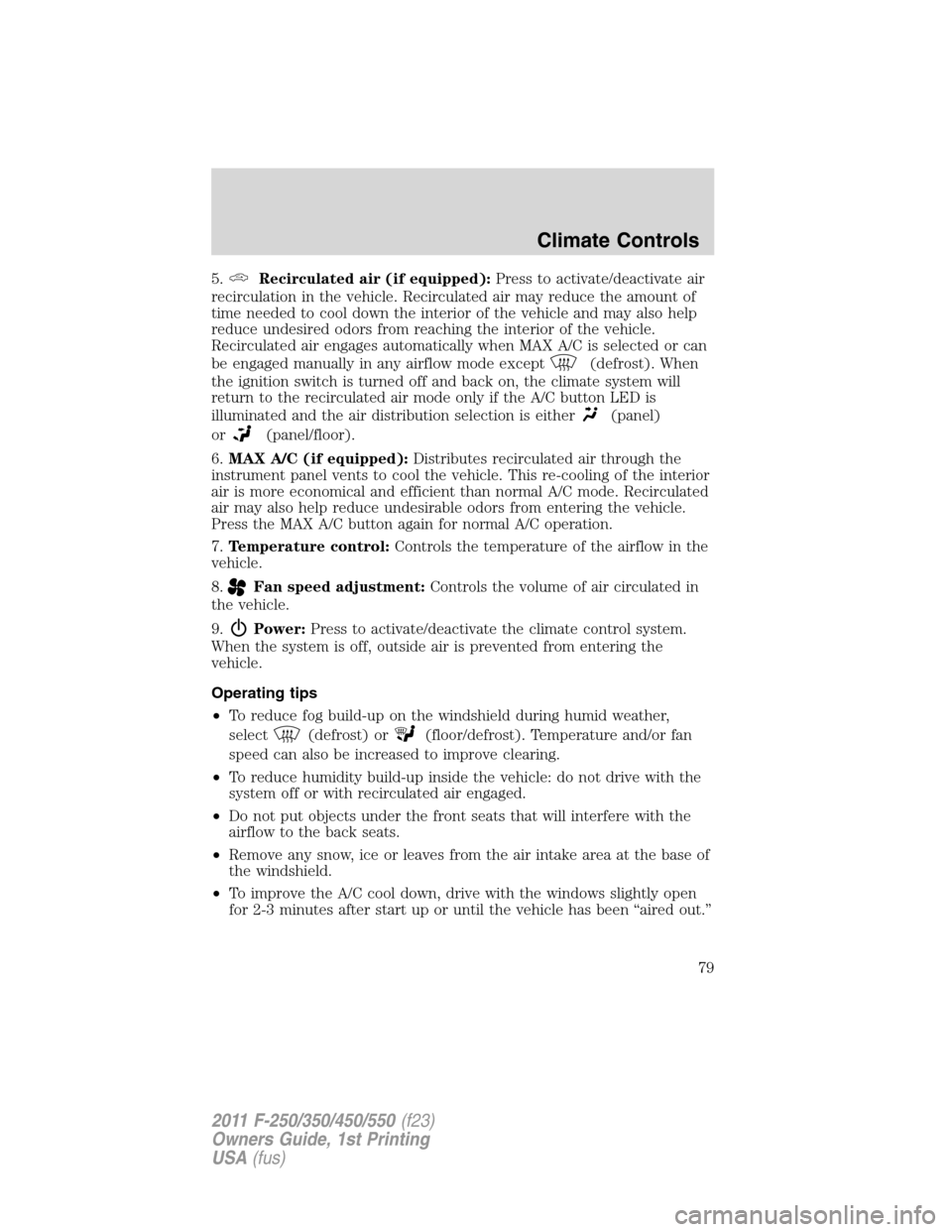
5.Recirculated air (if equipped):Press to activate/deactivate air
recirculation in the vehicle. Recirculated air may reduce the amount of
time needed to cool down the interior of the vehicle and may also help
reduce undesired odors from reaching the interior of the vehicle.
Recirculated air engages automatically when MAX A/C is selected or can
be engaged manually in any airflow mode except
(defrost). When
the ignition switch is turned off and back on, the climate system will
return to the recirculated air mode only if the A/C button LED is
illuminated and the air distribution selection is either
(panel)
or
(panel/floor).
6.MAX A/C (if equipped):Distributes recirculated air through the
instrument panel vents to cool the vehicle. This re-cooling of the interior
air is more economical and efficient than normal A/C mode. Recirculated
air may also help reduce undesirable odors from entering the vehicle.
Press the MAX A/C button again for normal A/C operation.
7.Temperature control:Controls the temperature of the airflow in the
vehicle.
8.
Fan speed adjustment:Controls the volume of air circulated in
the vehicle.
9.
Power:Press to activate/deactivate the climate control system.
When the system is off, outside air is prevented from entering the
vehicle.
Operating tips
•To reduce fog build-up on the windshield during humid weather,
select
(defrost) or(floor/defrost). Temperature and/or fan
speed can also be increased to improve clearing.
•To reduce humidity build-up inside the vehicle: do not drive with the
system off or with recirculated air engaged.
•Do not put objects under the front seats that will interfere with the
airflow to the back seats.
•Remove any snow, ice or leaves from the air intake area at the base of
the windshield.
•To improve the A/C cool down, drive with the windows slightly open
for 2-3 minutes after start up or until the vehicle has been “aired out.”
Climate Controls
79
2011 F-250/350/450/550(f23)
Owners Guide, 1st Printing
USA(fus)
Page 85 of 441
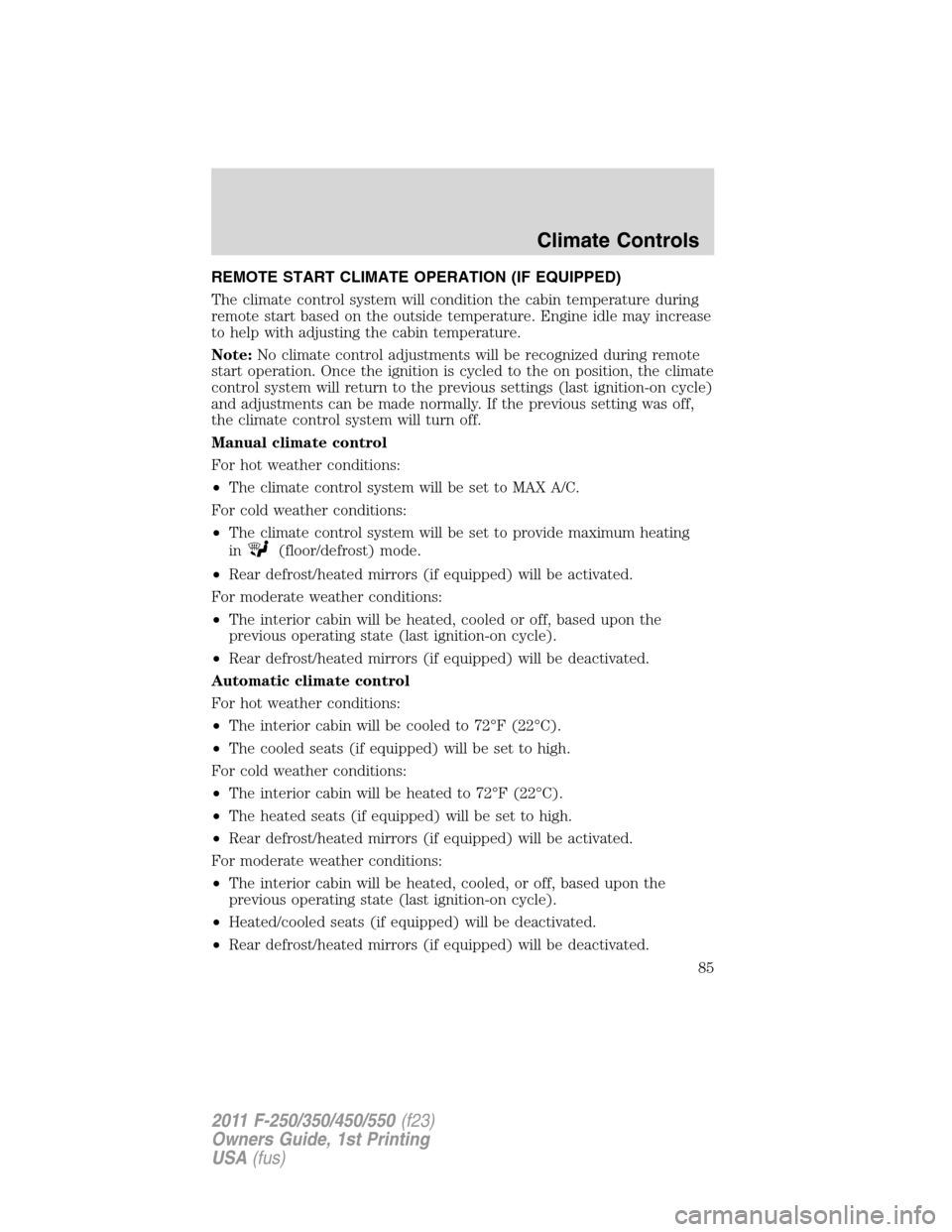
REMOTE START CLIMATE OPERATION (IF EQUIPPED)
The climate control system will condition the cabin temperature during
remote start based on the outside temperature. Engine idle may increase
to help with adjusting the cabin temperature.
Note:No climate control adjustments will be recognized during remote
start operation. Once the ignition is cycled to the on position, the climate
control system will return to the previous settings (last ignition-on cycle)
and adjustments can be made normally. If the previous setting was off,
the climate control system will turn off.
Manual climate control
For hot weather conditions:
•The climate control system will be set to MAX A/C.
For cold weather conditions:
•The climate control system will be set to provide maximum heating
in
(floor/defrost) mode.
•Rear defrost/heated mirrors (if equipped) will be activated.
For moderate weather conditions:
•The interior cabin will be heated, cooled or off, based upon the
previous operating state (last ignition-on cycle).
•Rear defrost/heated mirrors (if equipped) will be deactivated.
Automatic climate control
For hot weather conditions:
•The interior cabin will be cooled to 72°F (22°C).
•The cooled seats (if equipped) will be set to high.
For cold weather conditions:
•The interior cabin will be heated to 72°F (22°C).
•The heated seats (if equipped) will be set to high.
•Rear defrost/heated mirrors (if equipped) will be activated.
For moderate weather conditions:
•The interior cabin will be heated, cooled, or off, based upon the
previous operating state (last ignition-on cycle).
•Heated/cooled seats (if equipped) will be deactivated.
•Rear defrost/heated mirrors (if equipped) will be deactivated.
Climate Controls
85
2011 F-250/350/450/550(f23)
Owners Guide, 1st Printing
USA(fus)
Page 152 of 441
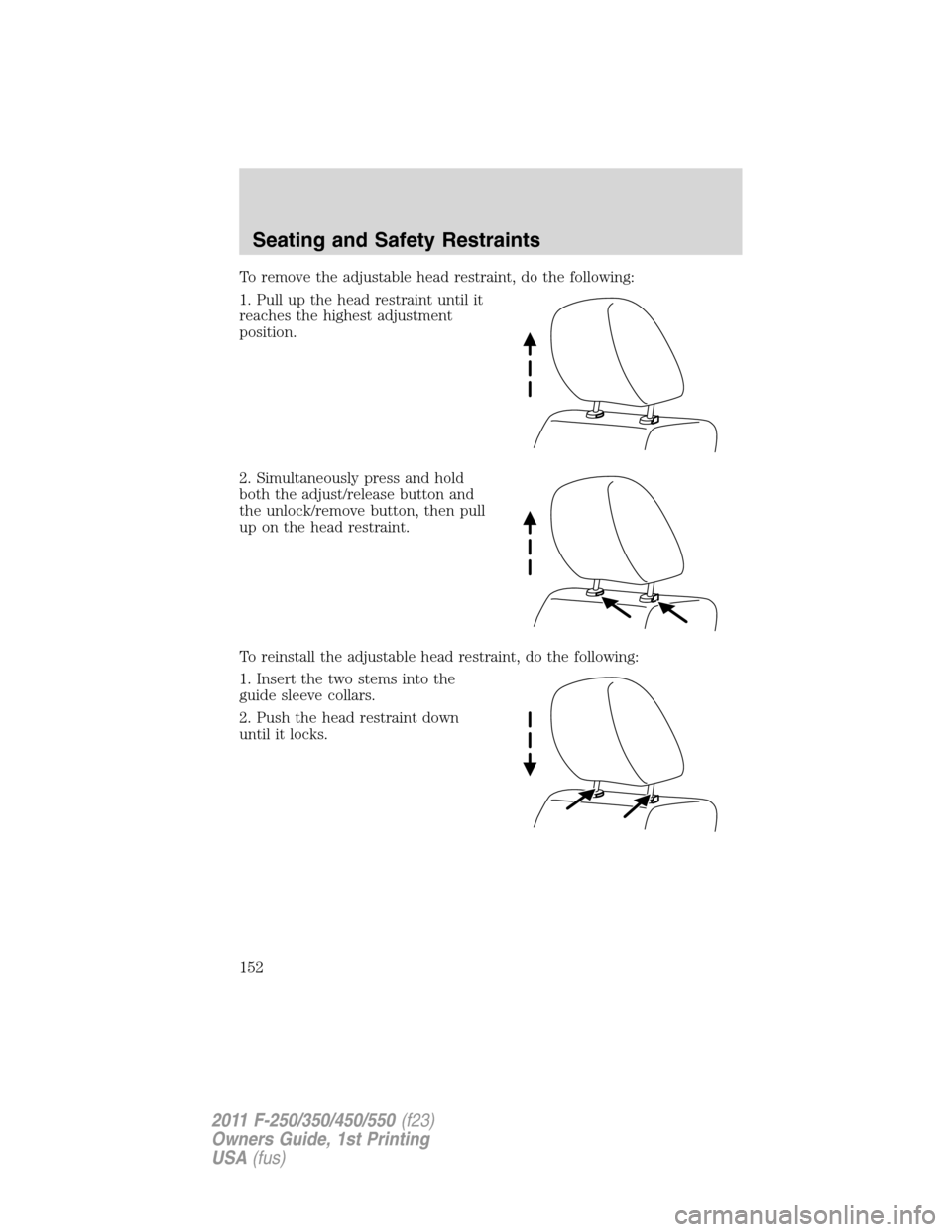
To remove the adjustable head restraint, do the following:
1. Pull up the head restraint until it
reaches the highest adjustment
position.
2. Simultaneously press and hold
both the adjust/release button and
the unlock/remove button, then pull
up on the head restraint.
To reinstall the adjustable head restraint, do the following:
1. Insert the two stems into the
guide sleeve collars.
2. Push the head restraint down
until it locks.
Seating and Safety Restraints
152
2011 F-250/350/450/550(f23)
Owners Guide, 1st Printing
USA(fus)
Page 168 of 441
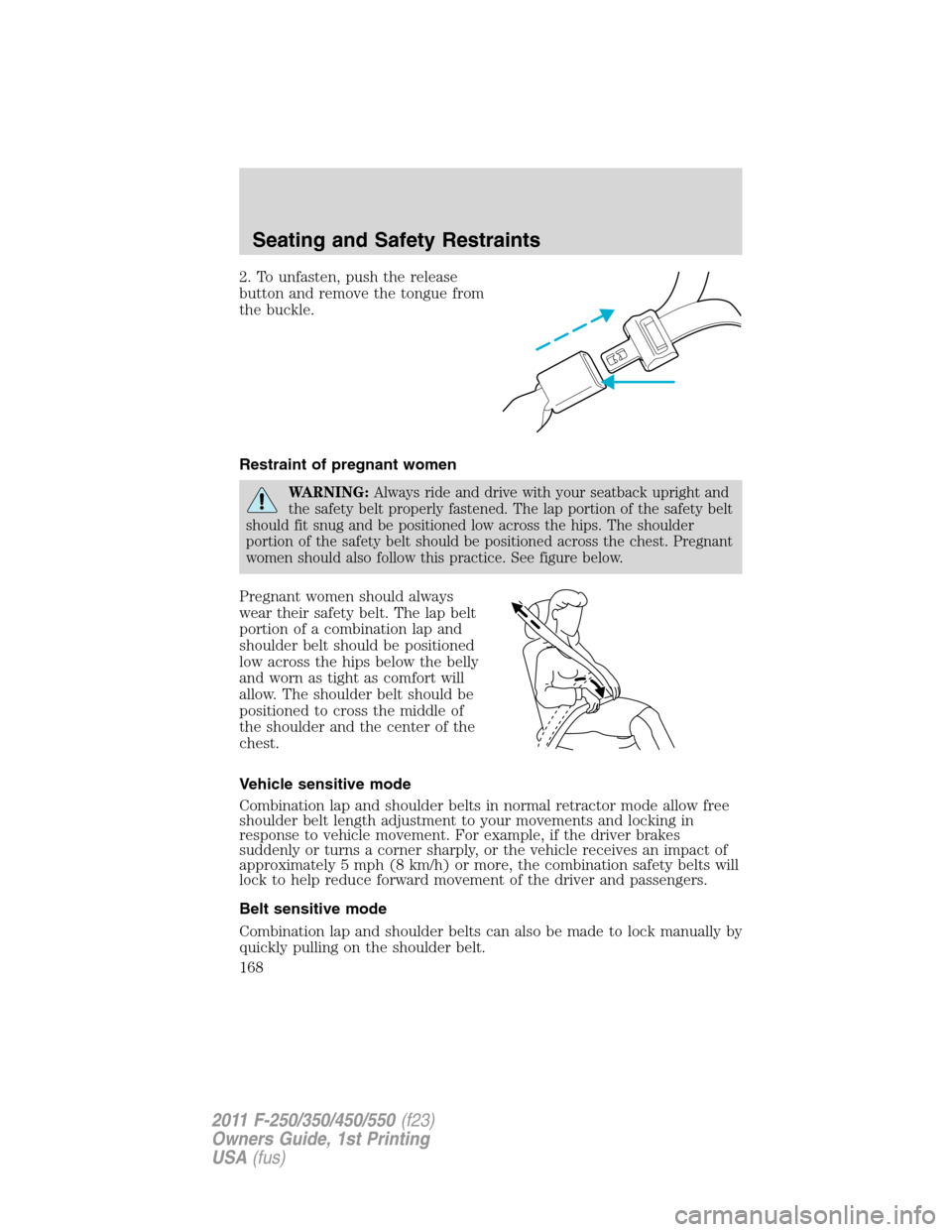
2. To unfasten, push the release
button and remove the tongue from
the buckle.
Restraint of pregnant women
WARNING:Always ride and drive with your seatback upright and
the safety belt properly fastened. The lap portion of the safety belt
should fit snug and be positioned low across the hips. The shoulder
portion of the safety belt should be positioned across the chest. Pregnant
women should also follow this practice. See figure below.
Pregnant women should always
wear their safety belt. The lap belt
portion of a combination lap and
shoulder belt should be positioned
low across the hips below the belly
and worn as tight as comfort will
allow. The shoulder belt should be
positioned to cross the middle of
the shoulder and the center of the
chest.
Vehicle sensitive mode
Combination lap and shoulder belts in normal retractor mode allow free
shoulder belt length adjustment to your movements and locking in
response to vehicle movement. For example, if the driver brakes
suddenly or turns a corner sharply, or the vehicle receives an impact of
approximately 5 mph (8 km/h) or more, the combination safety belts will
lock to help reduce forward movement of the driver and passengers.
Belt sensitive mode
Combination lap and shoulder belts can also be made to lock manually by
quickly pulling on the shoulder belt.
Seating and Safety Restraints
168
2011 F-250/350/450/550(f23)
Owners Guide, 1st Printing
USA(fus)
Page 171 of 441
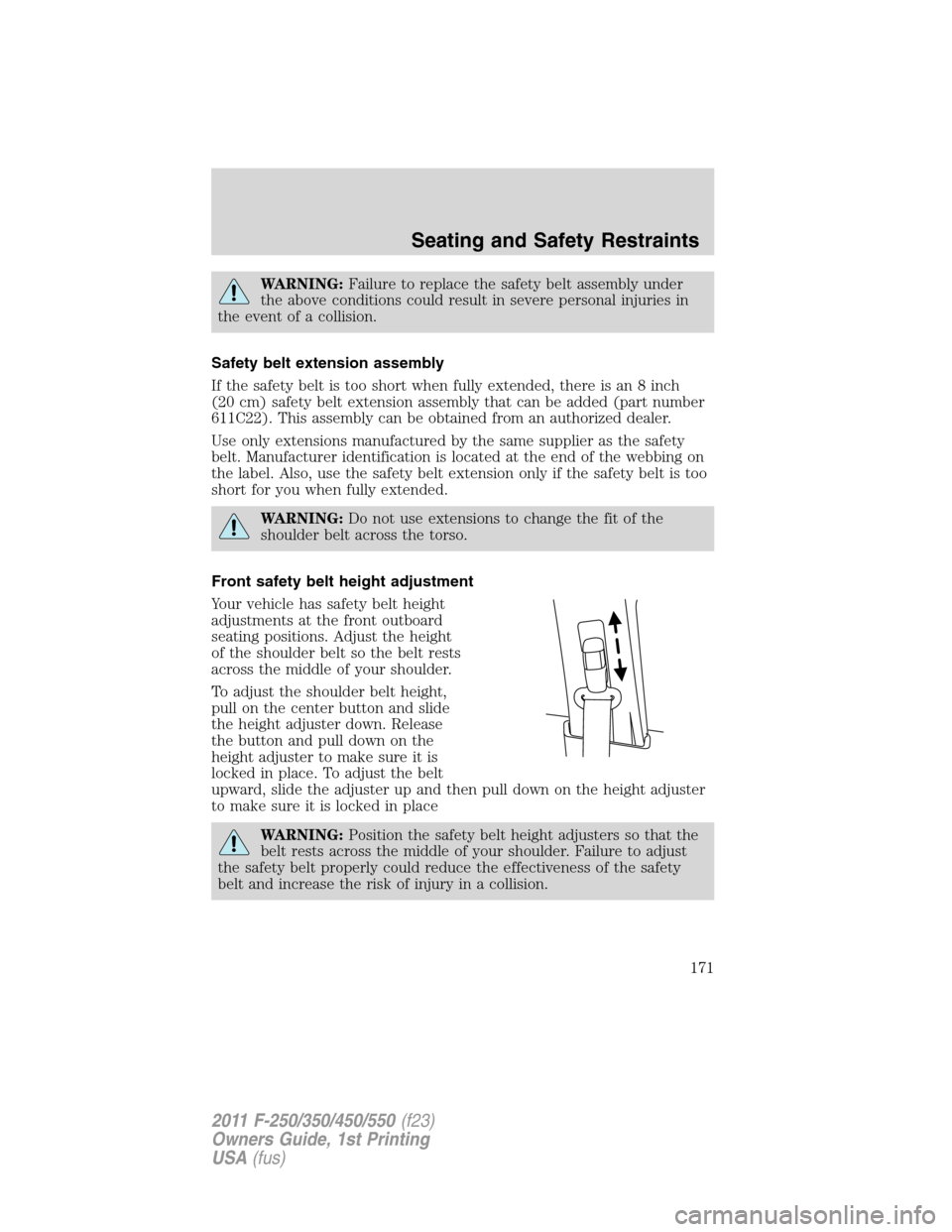
WARNING:Failure to replace the safety belt assembly under
the above conditions could result in severe personal injuries in
the event of a collision.
Safety belt extension assembly
If the safety belt is too short when fully extended, there is an 8 inch
(20 cm) safety belt extension assembly that can be added (part number
611C22). This assembly can be obtained from an authorized dealer.
Use only extensions manufactured by the same supplier as the safety
belt. Manufacturer identification is located at the end of the webbing on
the label. Also, use the safety belt extension only if the safety belt is too
short for you when fully extended.
WARNING:Do not use extensions to change the fit of the
shoulder belt across the torso.
Front safety belt height adjustment
Your vehicle has safety belt height
adjustments at the front outboard
seating positions. Adjust the height
of the shoulder belt so the belt rests
across the middle of your shoulder.
To adjust the shoulder belt height,
pull on the center button and slide
the height adjuster down. Release
the button and pull down on the
height adjuster to make sure it is
locked in place. To adjust the belt
upward, slide the adjuster up and then pull down on the height adjuster
to make sure it is locked in place
WARNING:Position the safety belt height adjusters so that the
belt rests across the middle of your shoulder. Failure to adjust
the safety belt properly could reduce the effectiveness of the safety
belt and increase the risk of injury in a collision.
Seating and Safety Restraints
171
2011 F-250/350/450/550(f23)
Owners Guide, 1st Printing
USA(fus)
Page 436 of 441

in rear seat ......................195, 202
LATCH .....................................202
Child safety seats - booster
seats ...........................................207
Cleaning your vehicle
engine compartment ..............354
instrument panel ............356–357
interior .....................................357
plastic parts ............................355
safety belts ..............................357
washing ....................................352
waxing .....................................353
wheels ......................................353
wiper blades ............................355
Climate control (see Air
conditioning or Heating) ......78, 81
Clock adjust
AM/FM/CD .................................64
Compass, electronic
set zone adjustment .................27
Console ........................................99
overhead ....................................99
Controls
power seat ...............................156
steering column ......................111
Coolant
checking and adding ..............370
refill capacities ................374, 400
Cruise control
(see Speed control) ..................109
Customer Assistance ................311
Ford accessories for your
vehicle .....................................360
Ford Extended Service
Plan ..................................411, 414
Getting assistance outside
the U.S. and Canada ..............349
Getting roadside assistance ...311Getting the service you
need .........................................345
Ordering additional owner’s
literature .................................351
Utilizing the
Mediation/Arbitration
Program ...................................349
D
Daytime running lamps
(see Lamps) ................................88
Defrost
rear window and rearview
mirrors .......................................81
windshield .................................81
Dipstick
automatic transmission
fluid ..........................................391
engine oil .................................366
Driving under special
conditions ..................288, 301, 304
sand .........................................303
snow and ice ...........................305
through water .................303, 307
E
Electronic message center ...22, 40
Emergencies, roadside
jump-starting ..........................340
Emergency Flashers .................312
Emission control system ..........387
Engine ........................................404
cleaning ...................................354
coolant .....................................370
diesel ...........................................6
fail-safe cooling .......................374
idle speed control ...................368
Index
436
2011 F-250/350/450/550(f23)
Owners Guide, 1st Printing
USA(fus)